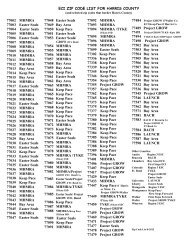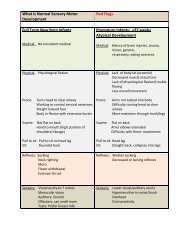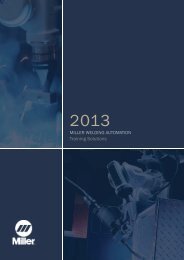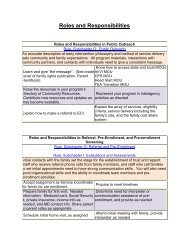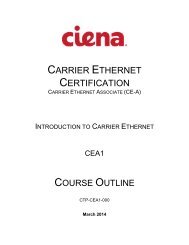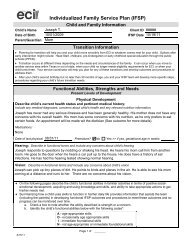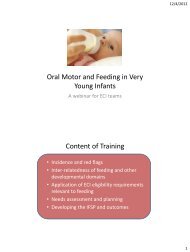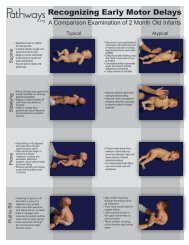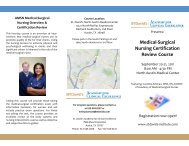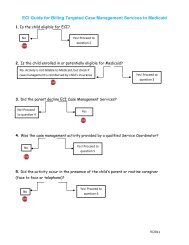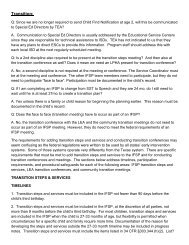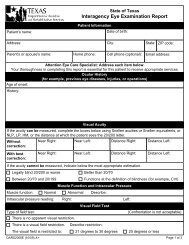BDI - 2 and Eligibility - ABC Signup
BDI - 2 and Eligibility - ABC Signup
BDI - 2 and Eligibility - ABC Signup
Create successful ePaper yourself
Turn your PDF publications into a flip-book with our unique Google optimized e-Paper software.
<strong>BDI</strong> - 2 <strong>and</strong> <strong>Eligibility</strong><br />
Medical Diagnosis <strong>and</strong> AI/VI <strong>Eligibility</strong><br />
1.<br />
Q: If a child has a documented qualifying medical diagnosis, how do we establish a need for<br />
ECI services What type of documentation is needed<br />
A: Once you have written medical documentation of the diagnosis the child is eligible for ECI<br />
services. Need for services must still be established before enrolling the child. This may<br />
be accomplished in one of two ways.<br />
a. Completion of the Functional Abilities, Strengths <strong>and</strong> Needs<br />
• The Present Levels of Development section of the IFSP required elements may be<br />
used to identify needs.<br />
• Documentation includes the completed form, <strong>and</strong> a progress note that describes the<br />
meeting with the parent. The needs identified should result in outcomes for the IFSP.<br />
b. A comprehensive tool that is intended to provide information for intervention planning<br />
may be administered, such as<br />
• the AEPS, the HELP Str<strong>and</strong>s, or the Carolina Curriculum<br />
• Documentation includes the completed protocol, <strong>and</strong> a progress note that describes<br />
the needs identified in discussion with the parent. The needs identified should result<br />
in outcomes for the IFSP.<br />
2.<br />
Q: Doesn’t a “need for ECI services” mean a developmental delay <strong>and</strong> the only way to<br />
document a delay is to administer the <strong>BDI</strong>-2<br />
A: No. A developmental delay can indicate a need for an ECI service, but some needs may<br />
be present without a documented delay. For example, a young infant with Down syndrome<br />
may not show a delay yet, but may have oral-motor traits, such as tongue-protrusion that<br />
will interfere with acquiring skills.<br />
3.<br />
Q: If a child is diagnosed with Autism during enrollment, do we have to do the <strong>BDI</strong>-2 at his<br />
annual<br />
A: No. Because the child has a qualifying medical diagnosis, you do not need to administer<br />
the <strong>BDI</strong>-2. You do need to document a need for ECI service. Any changes in eligibility<br />
during enrollment require a new <strong>Eligibility</strong> Statement, which must be reflected in TKIDS<br />
<strong>BDI</strong>-2<strong>and</strong><strong>Eligibility</strong> FY 2012 1<br />
09-06-11
<strong>BDI</strong> - 2 <strong>and</strong> <strong>Eligibility</strong><br />
4.<br />
Q: How do these changes affect AI or VI<br />
A: Remember that eligibility for children who meet the TEA requirements is determined by an<br />
interdisciplinary team that includes the AI or VI teacher. If a child has a documented hearing<br />
or vision loss but does not meet TEA requirements, ECI eligibility criteria must apply <strong>and</strong><br />
the child must exhibit a delay or have a qualifying medical diagnosis.<br />
5.<br />
Q: Can we administer the HELP for the AI kids for assessment purposes<br />
A: Yes. A comprehensive tool that is intended to provide information for intervention planning<br />
may be administered. Examples of such a tool include the AEPS, the HELP Str<strong>and</strong>s, <strong>and</strong><br />
the Carolina Curriculum.<br />
September 6, 2011<br />
6.<br />
Q: If upon referral we know the child will qualify as AI or VI, do we have to administer the<br />
<strong>BDI</strong>-2<br />
A: If you have documentation of AI or VI, the <strong>BDI</strong>-2 is not required, but the LEA must determine<br />
eligibility. If there is no documentation available yet, <strong>and</strong> the team believes that the child<br />
might have a developmental delay (like language delay in an older child), complete the<br />
<strong>BDI</strong>-2.<br />
Adjusting for Prematurity<br />
7.<br />
Q: The directions state “before 37 weeks” adjust for gestation. So for a child born at 37 weeks<br />
we do not adjust<br />
A: Correct, you do not adjust for children born at 37, 38 or 39 weeks.<br />
8.<br />
Q: Do you use the adjusted age to calculate the % delay for eligibility for premature children<br />
A: Yes<br />
<strong>BDI</strong>-2<strong>and</strong><strong>Eligibility</strong> FY 2012 2<br />
09-06-11
<strong>BDI</strong> - 2 <strong>and</strong> <strong>Eligibility</strong><br />
9.<br />
Q: The example on the instructions for the eligibility form gives the example of a 9 mo child <strong>and</strong><br />
the child is adjusted by 1.5 months, the result would be an adjusted age of 7.5. The<br />
instruction sheet says to look at the child as a 7 mo old, which is the opposite of what this<br />
training says. Please review prematurity again.<br />
A: This example is correct. You are ignoring the decimal once you adjust for the weeks of<br />
prematurity. This adjusted age is used to calculate percent of delay using either the<br />
excel AE-to-Percent Calculator or the Months to Percentage Delay Conversion<br />
table (both are located on the extranet documents under eligibility FY2012). Here<br />
are a couple of examples:<br />
a. Child is born at 33 weeks gestation <strong>and</strong> is 6 months old when eligibility is determined.<br />
40 - 33 = 7 weeks = 1.75 months<br />
6 months – 1.75 months = 4.25 months = 4 months adjusted age<br />
b. Child is born at 27 weeks gestation <strong>and</strong> is 15 months old when eligibility is determined.<br />
40 - 27 = 13 weeks = 3.25 months<br />
15 months – 3.25 months = 11.75 months = 11 months adjusted age<br />
Developmental Delay According to the <strong>BDI</strong>-2<br />
10.<br />
Q: For children who qualify due to a developmental delay or qualitative delay does a physical<br />
exam need to be obtained prior to enrollment<br />
A: No. Please review the 2012 rule related to IFSP.<br />
11.<br />
Q: When the domain AE score results in a decimal (4.5 months for example) do you round<br />
A: First subtract the AE from the chronological age to get months of delay, then round down,<br />
that is, drop anything after the decimal. This is reflected in the AE-to-Percent Calculator.<br />
<strong>BDI</strong>-2<strong>and</strong><strong>Eligibility</strong> FY 2012 3<br />
09-06-11
<strong>BDI</strong> - 2 <strong>and</strong> <strong>Eligibility</strong><br />
12.<br />
Q: What goes in the child’s chart when using the electronic version of the <strong>BDI</strong>-2<br />
A: The completed <strong>Eligibility</strong> Statement must be in the child’s record. When administering the<br />
<strong>BDI</strong>-2 using the Mobile Data Solution, the data manager generates a report called Complete<br />
<strong>BDI</strong>-2 Test Record Report. This should be in the child’s record in lieu of the test protocol.<br />
13.<br />
Q: If a child is not eligible <strong>and</strong> there are no concerns about his development, does the team<br />
then administer the HELP Str<strong>and</strong>s<br />
A: No. If a child is not eligible according to the <strong>BDI</strong>-2 <strong>and</strong> the team feels the test results are<br />
valid, the process is complete.<br />
14.<br />
Q: If the child qualifies on the <strong>BDI</strong>-2 but not according to clinical opinion, do you have to<br />
complete the HELP str<strong>and</strong>s<br />
A: No. However, if the team finds that there are no needs for intervention, the team’s rationale<br />
for this determination based on cultural, language or other differences must be fully documented.<br />
Please review the slides from the archived <strong>BDI</strong>-2 <strong>and</strong> <strong>Eligibility</strong> Webinar on August<br />
23 for more information about the application of Informed Clinical Opinion in this area.<br />
15.<br />
Q: When the child qualifies for ECI with a communication delay on the <strong>BDI</strong>-2, does a<br />
speech therapist need to be on the team to enroll the child Does this apply for other areas,<br />
for example, if the child has delay in fine motor, does an OT need to be on the team to<br />
enroll the child<br />
A: While it is always best to assign a team that includes professionals with expertise in the<br />
area(s) of concern for the child, this may not always be possible. An interdisciplinary team<br />
that meets the requirement in rule can administer the <strong>BDI</strong>-2 <strong>and</strong> determine eligibility based<br />
on the results.<br />
16.<br />
Q: For families with a primary language of Spanish does the Battelle have to be administered<br />
first in English If so how many domains or items need to be administered in order to stop<br />
<strong>and</strong> move to the Spanish Battelle.<br />
A: The examiner must determine the best means for addressing language-related issues during<br />
administration <strong>and</strong> test interpretation. See the <strong>BDI</strong>-2 Examiners Manual, page 12, for<br />
details.<br />
<strong>BDI</strong>-2<strong>and</strong><strong>Eligibility</strong> FY 2012 4<br />
09-06-11
<strong>BDI</strong> - 2 <strong>and</strong> <strong>Eligibility</strong><br />
17.<br />
Q: Has anyone considered contacting ASHA to discuss any professional liability we (SLPs)<br />
might expose ourselves to when administering a st<strong>and</strong>ardized test (<strong>BDI</strong>-2) across the state<br />
for the purposes of establishing eligibility regardless of the child’s cultural or linguistic com<br />
petence<br />
A: The <strong>BDI</strong>-2 is widely used around the country for eligibility determination for children birth<br />
to 3. There are no tools we are aware of that are st<strong>and</strong>ardized <strong>and</strong> normed for all of the<br />
languages that we must deal with in Texas. This is why the use of informed clinical opinion<br />
is important.<br />
September 6, 2011<br />
18.<br />
Q: A child qualifies for delay in gross motor <strong>and</strong> self-help, but does not qualify in communication,<br />
but is 33% behind in expressive language. Do we still check that they have a<br />
qualifying delay in expressive language on the eligibility form or leave that section blank<br />
because they had the qualifying delays in the other areas<br />
A: Expressive only would not be checked. On the <strong>Eligibility</strong> statement form, check all of the<br />
areas in which the child has a delay.<br />
19.<br />
Q: On the duration blank that is on the <strong>BDI</strong> 2: Is this just the actual time you administer the test<br />
or do you include getting the medical, administering the HELP, discussion with team<br />
members etc.<br />
A: On the <strong>Eligibility</strong> Statement Form in the duration blank, enter the amount of time that the<br />
team spent on the evaluation to determine eligibility, or if an evaluation is not required,<br />
the time spent on the comprehensive needs assessment.<br />
20.<br />
Q: If you have siblings that need to be assessed- should we do both at one time with two<br />
assessment teams in the home or do we assess one child at a time. If we do both at the<br />
same time how do we keep the parent involved in both assessments If we do one at<br />
a time, does it create a problem if one child observes his/her sibling<br />
doing items on the Battelle<br />
A: ECI has always required that parents be involved in the evaluation process. The <strong>BDI</strong>-2 is<br />
not different in this respect. Conduct evaluations on siblings in the same way that you have<br />
always done. If a young child observes his sibling complete an item, it should have no<br />
effect on his ability or inability to complete the same item.<br />
<strong>BDI</strong>-2<strong>and</strong><strong>Eligibility</strong> FY 2012 5<br />
09-06-11
<strong>BDI</strong> - 2 <strong>and</strong> <strong>Eligibility</strong><br />
Developmental Delay-Qualitative Determination<br />
21.<br />
Q: When a child is eligible based on a qualitative determination of delay, eligibility is<br />
re-determined within 6 months. How long do we write the IFSP for<br />
A: Write the IFSP for 6 months because the child is no longer eligible after 6 months without a<br />
determination of delay that meets continuing eligibility criteria.<br />
22.<br />
Q: Does a team have to administer the HELP <strong>and</strong> PLS or can one person<br />
A: One team member may take primary responsibility for administration of items; however<br />
eligibility decisions must be made by the interdisciplinary team.<br />
September 6, 2011<br />
23.<br />
Q: ECI has selected the HELP Str<strong>and</strong>s for Qualitative <strong>Eligibility</strong>. This is another developmental<br />
assessment being given to a child who has supposedly passed the st<strong>and</strong>ardized developmental,<br />
<strong>BDI</strong>-2, but has shown signs of qualitative differences. For speech problems, the<br />
professional has the option of using the Preschool Language Scale which specifically deals<br />
with speech <strong>and</strong> language problems. For a child exhibiting possible sensory processing issues,<br />
the professional is limited to using the HELP STRANDS in social/emotional, gross <strong>and</strong><br />
fine motor areas. Items in these areas will not necessarily identify sensory processing problems.<br />
However, the Help Str<strong>and</strong>s include a section title, Regulatory/Sensory Organization,<br />
which, while not comprehensive, might better identify these children. Why was this section of<br />
the HELP STRANDS not included in the eligibility determination Also, there are st<strong>and</strong>ardized<br />
tests that are aimed at identifying sensory processing disorders which might be better<br />
choices. Based on 38 years of clinical pediatric experience <strong>and</strong> assessing young children<br />
with sensory processing problems, I am convinced that early intervention is critical in helping<br />
these children to deal with their environment more effectively, helping these families to deal<br />
with these difficult children, <strong>and</strong>, eventually, allowing these children to function maximally in<br />
their school environment.<br />
A: Sensory processing does not st<strong>and</strong> alone as a qualifying diagnosis; a child must demonstrate<br />
a delay that results in functional limitations to qualify for services. If a child has sensory<br />
issues that are severe enough, they will manifest in areas of behavior, exploration of<br />
environment, balance <strong>and</strong> coordination etc that will be identified through administration of<br />
the <strong>BDI</strong>-2 or through process for qualitative determination of delay.<br />
<strong>BDI</strong>-2<strong>and</strong><strong>Eligibility</strong> FY 2012 6<br />
09-06-11
<strong>BDI</strong> - 2 <strong>and</strong> <strong>Eligibility</strong><br />
The Preschool Language Scale is available for use only in the very specific circumstance<br />
when the child’s primary language is not English or there is a prominent second language in<br />
the child’s environment. This step is taken to ensure that a child does not qualify based on<br />
cultural or language difference.<br />
Developmental Delay-Qualitative Determination-Use of the HELP Str<strong>and</strong>s<br />
24.<br />
Q: Do you need to get consent when using HELP Str<strong>and</strong>s even if you saw information while<br />
doing <strong>BDI</strong>-2<br />
A: Yes. Consent is needed any time you administer a tool to determine eligibility.<br />
25.<br />
Q: Are the HELP Str<strong>and</strong>s listed on the eligibility statement form the only ones we have to<br />
administer for a qualitative determination of eligibility<br />
A: The listed str<strong>and</strong>s are the only str<strong>and</strong>s used to determine eligibility, <strong>and</strong> these are the only<br />
str<strong>and</strong>s for which a delay is calculated. It is only necessary to administer the designated<br />
HELP str<strong>and</strong>s that are needed to gather information about the developmental area(s) of<br />
concern. Other str<strong>and</strong>s can be administered for intervention planning but cannot be used for<br />
eligibility determination.<br />
26.<br />
Q: Does a ST have to determine intelligibility of speech <strong>and</strong> an OT for Gross Motor qualitative<br />
delay<br />
A: No. The HELP Str<strong>and</strong>s do not have requirements regarding the makeup of the team.<br />
According to the instructions for the eligibility statement form, the LPHA on the team that<br />
makes the determination must be knowledgeable in the area of concern <strong>and</strong> be acting within<br />
the scope of their professional license.<br />
27.<br />
Q: Will each evaluation team need to have the Inside Help available Can that be ordered<br />
separately from the actual str<strong>and</strong>s<br />
A: Every professional who participates in eligibility determination must be familiar with the<br />
information in the Inside HELP. The number of copies that a program purchases is a local<br />
decision. It can be ordered separately.<br />
<strong>BDI</strong>-2<strong>and</strong><strong>Eligibility</strong> FY 2012 7<br />
09-06-11
<strong>BDI</strong> - 2 <strong>and</strong> <strong>Eligibility</strong><br />
28.<br />
Q: How do the HELP Str<strong>and</strong>s fit in to the entire eligibility determination process It seems like<br />
it will take a long time. Also, I know ideally it should be done on the same visit, but we may<br />
not have the appropriate LPHA for the area in question present.<br />
A: Administering the HELP Str<strong>and</strong>s to do a qualitative determination of eligibility should not<br />
be time consuming, adding perhaps 15 minutes to the length of the session. You only need<br />
to score the str<strong>and</strong>s for the area(s) of concern. Additionally, you may have already observed<br />
or the parent has reported information that allows you to score items on the HELP Str<strong>and</strong>s.<br />
The HELP Str<strong>and</strong>s do not have requirements regarding the makeup of the team. According<br />
to the instructions for the eligibility statement form, the LPHA on the team that makes the<br />
determination must be knowledgeable in the area of concern <strong>and</strong> be acting within the scope<br />
of their professional license. If the LPHA who is present does not meet these criteria,<br />
you will need to return to the home with the appropriate team.<br />
29.<br />
Q: Will there be training offered on the HELP str<strong>and</strong>s<br />
A: No. Guidance can be found in the Inside HELP <strong>and</strong> the VORT website.<br />
www.vort.com/osep/Guidelines_for_Determining_Approximate_DALs_for_HELP_Str<strong>and</strong>s.pdf<br />
September 6, 2011<br />
30.<br />
Q: When determining eligibility using qualitative determination of delay <strong>and</strong> the HELP Str<strong>and</strong>s,<br />
can the child qualify based on any percent of delay or does it have to be 25%<br />
A: It must be a delay of 25% or greater.<br />
31.<br />
Q: I was looking on VORT Corp today – there are two types of HELP Str<strong>and</strong>s – one is a 32<br />
page booklet <strong>and</strong> one is a 4 page unbound sections. Which does the state want us to<br />
order<br />
A: We recommend that you purchase the unbound Str<strong>and</strong>s 158-U. This will allow you to take<br />
the instrument apart, <strong>and</strong> use one protocol for up to 5 children. Don’t forget to also pur<br />
chase the “Inside HELP” manuals.<br />
<strong>BDI</strong>-2<strong>and</strong><strong>Eligibility</strong> FY 2012 8<br />
09-06-11
<strong>BDI</strong> - 2 <strong>and</strong> <strong>Eligibility</strong><br />
32.<br />
Q: If the <strong>BDI</strong> shows the child to have a delay in an area that would qualify the child, but<br />
the team does not feel the child should be determined as eligible (i.e., cultural issues, no<br />
opportunity to practice the skill),do we need to use the HELP Str<strong>and</strong>s or PLS to make that<br />
decision<br />
A: No. See # 27 on the Instructions for the <strong>Eligibility</strong> Statement Form: “Due to cultural,<br />
language or other differences, the <strong>BDI</strong>-2 may indicate eligibility but the team does not agree<br />
based on informed clinical opinion. Document a complete description <strong>and</strong> justification.<br />
Use additional pages if needed.<br />
33.<br />
Q: Does the HELP Str<strong>and</strong> always have to be administered by the “expert” in the area or can<br />
any LPHA administer<br />
A: The HELP Str<strong>and</strong>s maybe administered by anyone on the team. Please refer to #28 on the<br />
Instructions for the <strong>Eligibility</strong> Statement Form which says that the team must include<br />
an LPHA who is knowledgeable in the area of concern who is acting within the scope of his/<br />
her professional license. The LPHA must determine whether s/he meets these criteria<br />
for any individual child.<br />
Developmental Delay-Qualitative Determination-Use of the Preschool Language<br />
Scale<br />
34.<br />
Q: I am confused about why we would use PLS if “the child appears to qualify based solely on<br />
language scores on the <strong>BDI</strong>-2” <strong>and</strong> “the primary language is not English or there is a<br />
prominent 2nd language in the child’s environment”<br />
A: Further information about a child’s language development is needed to ensure that a child<br />
does not qualify based on language differences rather than an actual delay. Please review<br />
the archived webinar series regarding Cultural <strong>and</strong> Language considerations presented<br />
on Aug 10, 24, <strong>and</strong> 31.<br />
<strong>BDI</strong>-2<strong>and</strong><strong>Eligibility</strong> FY 2012 9<br />
09-06-11
<strong>BDI</strong> - 2 <strong>and</strong> <strong>Eligibility</strong><br />
35.<br />
Q: For a child with a communication delay on the <strong>BDI</strong>-2 whose primary language is not English,<br />
can we use the HELP as a supplemental tool rather than the PLS<br />
A: No, there are no HELP Str<strong>and</strong>s identified for this determination. The Preschool Language<br />
Scale may be used to gather more detailed information about the child’s language abilities<br />
when:<br />
• the child appears to qualify based solely on language scores on the <strong>BDI</strong>-2, <strong>and</strong><br />
• the primary language is not English or there is a prominent second language in the<br />
child’s environment<br />
This step is taken to ensure that a child does not qualify based on cultural or language<br />
differences.<br />
36.<br />
Q: This slide says PLS “may be used” - must it be used<br />
A. No, there is no requirement that the PLS be used. The Preschool Language Scale may be<br />
used to gather more detailed information about the child’s language abilities when:<br />
• the child appears to qualify based solely on language scores on the <strong>BDI</strong>-2, <strong>and</strong><br />
• the primary language is not English or there is a prominent second language in the<br />
child’s environment<br />
This step is taken to ensure that a child does not qualify based on cultural or language<br />
differences.<br />
37.<br />
Q: Aetna does not accept the PLS <strong>and</strong> has directed us to have SLP’s use the REEL. We have<br />
done this <strong>and</strong> started receiving reimbursement. Is this acceptable<br />
A: <strong>Eligibility</strong> for ECI services is primarily determined by the <strong>BDI</strong>-2, <strong>and</strong> the HELP Str<strong>and</strong>s may<br />
supplement when needed. The PLS is used only for a small group of very specific children<br />
when the team believes the <strong>BDI</strong>-2 score is not valid for children with language differences.<br />
The REEL should be used rarely, <strong>and</strong> only as an assessment for planning intervention.<br />
<strong>BDI</strong>-2<strong>and</strong><strong>Eligibility</strong> FY 2012 10<br />
09-06-11
<strong>BDI</strong> - 2 <strong>and</strong> <strong>Eligibility</strong><br />
Developmental Delay-Qualitative Determination for Children Less Than 3 Months<br />
of Age<br />
38.<br />
Q: Do we administer the <strong>BDI</strong>-2 for children whose chronological or adjusted age is under 3<br />
months<br />
A: Yes. You must administer the <strong>BDI</strong>-2 for children who do not have a qualifying medical<br />
diagnosis or AI/VI, regardless of age. If a child under 3 months does not qualify based on<br />
the <strong>BDI</strong>-2 <strong>and</strong> there are still concerns, you will use page 3 of the <strong>Eligibility</strong> Statement to<br />
document a qualitative determination of delay.<br />
39.<br />
Q: Can a RN determine eligibility for a child younger than 3 months of age<br />
A: For qualitative determination of delay for children under the age of 3 months, the team must<br />
include a therapist acting within the scope of their professional license to lead the team<br />
in identifying the concern. Since the categories are communication/oral motor <strong>and</strong> motor, an<br />
RN does not meet the requirement.<br />
Determination of Continuing <strong>Eligibility</strong><br />
40.<br />
Q: How will we h<strong>and</strong>le re-evaluation of children who are due for annual Can they be<br />
re-evaluated with the DAYC or will we have to switch to <strong>BDI</strong>-2<br />
A: The <strong>BDI</strong>-2 is required for annual eligibility determination as of September 1, 2011.<br />
41.<br />
Q: Do we use this eligibility statement for re-evaluations since the criteria for continuing<br />
eligibility is different than that of initial eligibility.<br />
A: Yes. Please see #42 of the instructions for the eligibility statement form.<br />
<strong>BDI</strong>-2<strong>and</strong><strong>Eligibility</strong> FY 2012 11<br />
09-06-11
<strong>BDI</strong> - 2 <strong>and</strong> <strong>Eligibility</strong><br />
September 6, 2011<br />
42.<br />
Q: Since eligibility has to be re-determined for some children after 6 months, do we calculate<br />
the 6 months from the initial IFSP date, <strong>BDI</strong>2 date, or the HELP date Then when is the<br />
annual eligibility due<br />
A: According to TAC 108.807(2) a child whose initial eligibility was based on a qualitative<br />
determination of delay is eligible for up to six months. Use the enrollment (IFSP) date<br />
to calculate the date for continuing eligibility determination. Annual eligibility for children<br />
who re-qualify at six months is due one year from the date of the re-determination.<br />
Example:<br />
Qualitative determination of delay <strong>and</strong> IFSP: 10/1/11<br />
Continuing eligibility determined using the <strong>BDI</strong>-2 : 3/31/12<br />
Annual continuing eligibility determined using the <strong>BDI</strong>-2 : 3/31/13<br />
43.<br />
Q: If a child initially qualifies using the <strong>BDI</strong>2 <strong>and</strong> then at the annual they no longer qualify.<br />
What if they have had a traumatic event in the last few months, they don’t qualify on the<br />
<strong>BDI</strong>-2, but they would qualify at the annual with the HELP<br />
A: To be eligible at the annual, a child must qualify on the <strong>BDI</strong>-2.<br />
44.<br />
My question has two parts:<br />
Q: For children we qualified as atypical in FY 11 whose 6 month reviews are due in FY 12 do<br />
we re-determine eligibility for them at six months<br />
A: No. Any child whose eligibility was determined prior to September 1, 2011 remains eligible<br />
for one year or until age 3, as long as there is a continued need for services. If the team<br />
questions the eligibility of a child due to the child’s progress, they can re-determine eligibility<br />
at any point during the year.<br />
45.<br />
Q: Children who have a qualitative determination of delay on or after September 1, 2011 must<br />
re-qualify under developmental delay at 6 month review, is that correct<br />
A: Yes. A child whose initial eligibility was based on a qualitative determination of delay is<br />
eligible for up to six months. When re-tested at 6 months, he must show a qualifying delay<br />
(continuing eligibility criteria) on the <strong>BDI</strong>-2.<br />
<strong>BDI</strong>-2<strong>and</strong><strong>Eligibility</strong> FY 2012 12<br />
09-06-11
<strong>BDI</strong> - 2 <strong>and</strong> <strong>Eligibility</strong><br />
46.<br />
Q: What percent delay is required for continuing eligibility when a child qualifies in expressive<br />
delay only Is it a 25% delay<br />
A: Rule 108.807 (3): For all other children to remain eligible the child must demonstrate a<br />
documented delay of at least 15% in one or more areas of development.<br />
September 6, 2011<br />
Data<br />
47.<br />
Q: When will TKIDS be changed to reflect the changes to the eligibility statement<br />
A: We anticipate the changes to TKIDS the first week of October. We will soon send additional<br />
information regarding data entry in TKIDS.<br />
48.<br />
Q: Where can I find the webinars on the <strong>BDI</strong>-2 Data Manager <strong>and</strong> Mobile Data Solution<br />
A: Riverside has archived both types of webinars <strong>and</strong> some written materials to assist you in<br />
the use of the Data Manager <strong>and</strong> the Mobile Data Solution. They can be accessed at<br />
http://www.riversidepublishing.com/bdi2tx/ .<br />
September 6, 2011<br />
Other<br />
49.<br />
Q: When a child has been determined eligible for comprehensive services using the <strong>BDI</strong>-2 or<br />
other designated tool (HELP/PLS), can a therapist providing a discipline specific<br />
evaluation use a different tool to determine additional service needs Example: child<br />
enrolled due to motor delay by IDT including PT. After some months, providers recommend<br />
a speech evaluation due to lack of expected progress in communication. Can the SLP use<br />
a tool other than the «official» one (Rossetti, Goldman-Fristoe)<br />
A: Yes. The requirements regarding eligibility determination do not affect the use of other in<br />
struments that may be used for needs assessment.<br />
<strong>BDI</strong>-2<strong>and</strong><strong>Eligibility</strong> FY 2012 13<br />
09-06-11
<strong>BDI</strong> - 2 <strong>and</strong> <strong>Eligibility</strong><br />
50.<br />
Q: A child was found eligible under DD using the <strong>BDI</strong>-2. At a later point in the year the team<br />
wants to refer the child for a discipline specific evaluation due to growing concerns in<br />
a specific area-i.e. speech evaluation. We would like to use the appropriate section(s) of the<br />
HELP for this discipline specific evaluation-this seems to be in agreement<br />
with the rule related to Subchapter I Evaluation <strong>and</strong> Assessment. We know we cannot use<br />
the domain section of the <strong>BDI</strong>-2 for this discipline specific evaluation due to the requirement<br />
to use it in its entirety.<br />
A: There are no requirements regarding needs assessment. Professionals may use any<br />
appropriate tests or procedures, including administration of any or all sections of the HELP<br />
Str<strong>and</strong>s.<br />
51.<br />
Q: Rule continues to state that the DARS ECI Screening Packet can be used for screening<br />
purposes. We had moved to the one page needs assessment <strong>and</strong> doing it during the<br />
evaluation for eligibility. However, since the <strong>BDI</strong>-2 is going to be longer <strong>and</strong> much more<br />
structured, staff have asked about moving back to the DARS ECI Screening Packet <strong>and</strong><br />
completing the this portion during the intake process as in the past. Want to be sure that it<br />
continues to be ok to administer the screenings prior to establishing eligibility <strong>and</strong> also if<br />
there is a preference to the methodology used<br />
A: The ECI Needs Assessment, Identification & Referral was designed to streamline the<br />
process <strong>and</strong> ensure that children with concerns are identified. It should not add<br />
significant time as it uses <strong>BDI</strong>-2 items that are administered to determine eligibility. The<br />
<strong>BDI</strong> 2 has a wealth of information about vision that is collected during administration of<br />
the tool, <strong>and</strong> the hearing criteria are based solely on the presence of a communication<br />
delay. Using the Screening Packet is an allowable option for 2012. Use of the DARS ECI<br />
Screening packet <strong>and</strong> intake visits should not occur frequently within a streamlined, efficient<br />
process. A better use of resources would be to provide some checklists or other tools to<br />
assist staff in collecting all the information during this transitional period.<br />
<strong>BDI</strong>-2<strong>and</strong><strong>Eligibility</strong> FY 2012 14<br />
09-06-11




